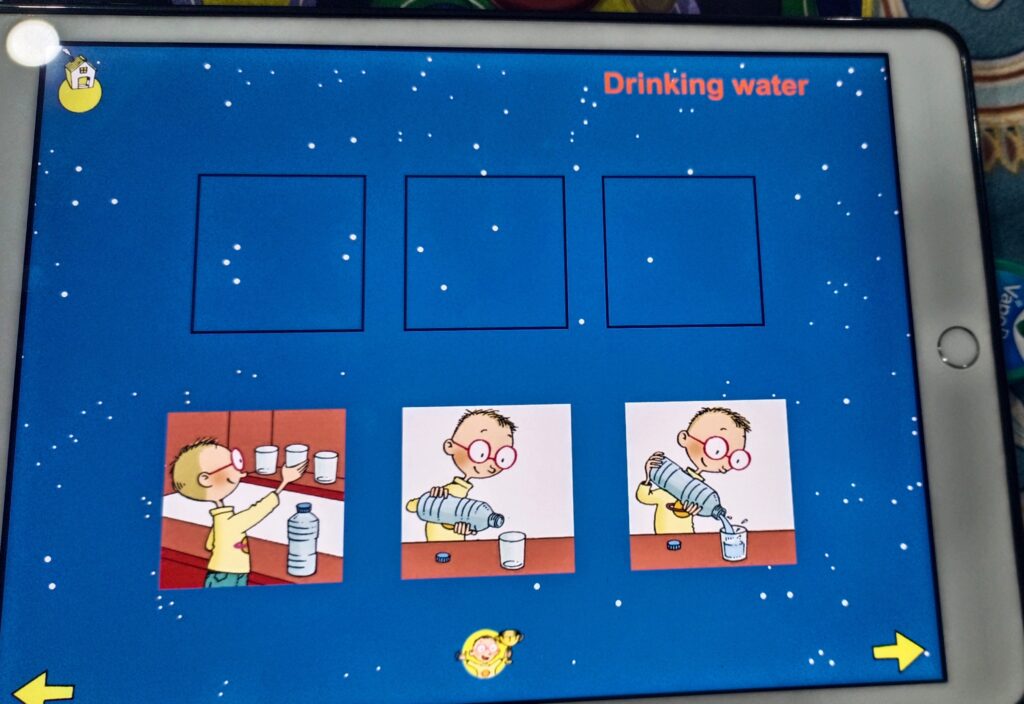As children with delayed speech and language, including those with autism and language disorders, begin to grasp their first 100-200 words, then combine them in two words and start forming sentences. They may still face challenges in effectively communicating their thoughts. The next step in their language journey is to build sentence structures and enhance vocabulary through structured daily activities. This Vocabulary Development Program Level 2 is designed to address this challenge, using short, everyday sequences that help children practice words, phrases, and sentences. The program draws inspiration from iSequences and is crafted to guide children from basic vocabulary to more complex sentence structures.
Program Overview
This program starts when children have developed some foundational vocabulary but need help transitioning to meaningful communication. By using familiar, short sequences from daily life, children not only learn new words but also begin to understand “what to say next,” a crucial skill for effective expression. These structured activities are particularly beneficial for children with limited language abilities due to autism or other speech and language disorders.
The sequences progress from simple words to full sentences, helping children generalize this learning into real-life scenarios. The method involves three key steps:
- Arrange the sequence and speak words for each picture.
- Progress to speaking phrases that describe each picture.
- Encourage the child to create and speak their own sentences for each picture.
- Generalize the learned words, phrases, and sentences at home by using them during the actual activities.
Technique in Action
The sequences used are based on short, familiar events from daily life, such as drinking water, brushing teeth, and getting dressed. As children engage with these sequences, they build their understanding of vocabulary, sequence of events, and sentence construction.
Step-by-Step Process:
- Download iSequences app
- Learn to arrange the sequence and say words for each picture: Start with visual prompts that depict a sequence of events. For example, when a child sees a picture of someone drinking water, they learn words like “glass,” “pour,” “water.”
- Speak phrases for each picture and complete the sequence: After learning individual words, the child is encouraged to form short phrases, such as “pour water” or “drinking water.”
- Make sentences and speak for each picture: The final step is encouraging the child to create their own full sentences to describe the pictures, such as “The man is drinking water.”
- Generalization in real-life scenarios: Once the child is comfortable with the sequences, generalize the learning by using the same vocabulary and sentences during actual daily activities. For example, during the morning routine, the parent can say, “It’s wake-up time,” or, “Let’s put on your shoes,” reinforcing the vocabulary.
Sequences, Vocabulary, and Example Sentences
Sequence 1: Drinking Water
- Max picks up the glass.
- Max pours water.
- The glass is full.
- He drinks water.
Vocabulary:
- Glass
- Pour
- Full
- Drinks
- Water
Sequence 2: Brushing Teeth
- Put paste on the brush.
- Brushing teeth.
- Spitting and rinsing.
- Opening mouth.
- Teeth are all clean.
Vocabulary:
- Paste
- Brush
- Spitting
- Rinsing
- Mouth
- Clean
Sequence 3: Eating
- Boy has food on the plate.
- Eating food.
- Food is finished.
- He goes to the kitchen.
- Keeps the plate in the kitchen.
Vocabulary:
- Food
- Plate
- Finished
- Kitchen
- Keeps
Sequence 4: Using the Washroom
- Sitting on the pot.
- Taking toilet roll/tissue.
- Cleaning with tissue.
- Flushing.
- Washing hands.
Vocabulary:
- Pot
- Toilet roll
- Tissue
- Cleaning
- Flushing
- Washing hands
Sequence 5: Getting Dressed/Going to School
- Wakes up in the morning.
- Wearing clothes.
- Wearing shoes.
- Ready.
- Opens the door.
Vocabulary:
- Wake up
- Morning
- Clothes
- Shoes
- Ready
- Door
Conclusion
This Vocabulary Development Program Level 2 provides children with the tools to transition from basic vocabulary to meaningful sentence structures by practicing sequences from daily life. It’s not just about learning words; it’s about understanding their function in real contexts and developing communication skills that can be generalized to real-life situations. By encouraging children to follow these steps, parents and educators can foster both language development and confidence in expression.

